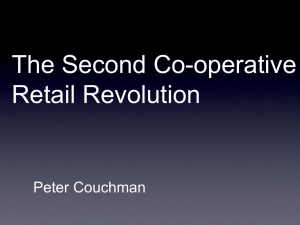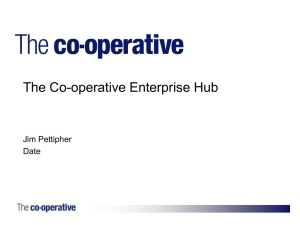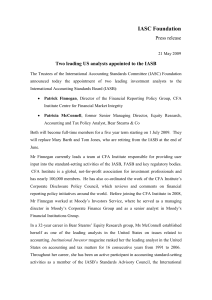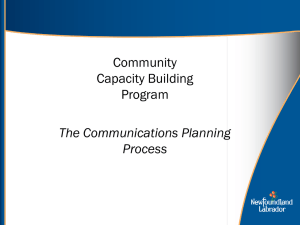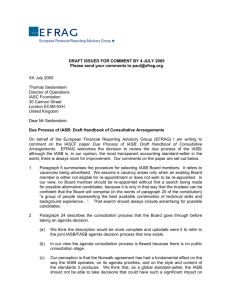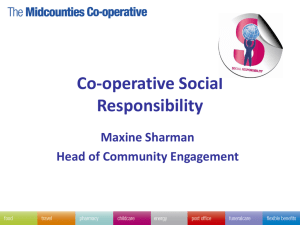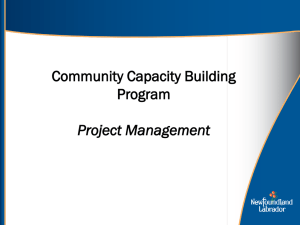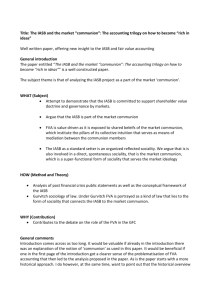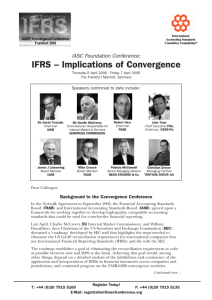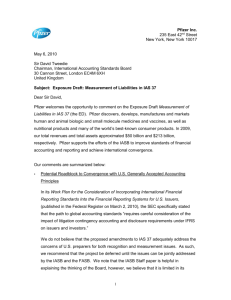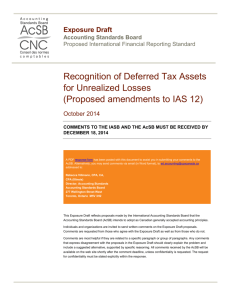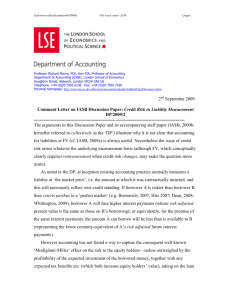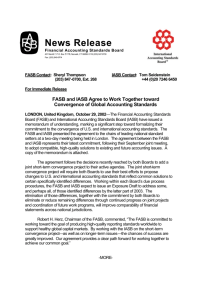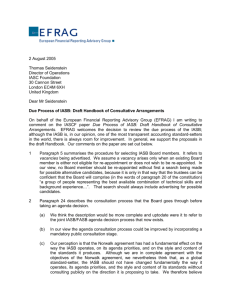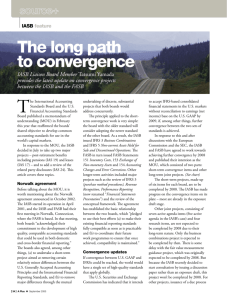Dear Sirs
advertisement
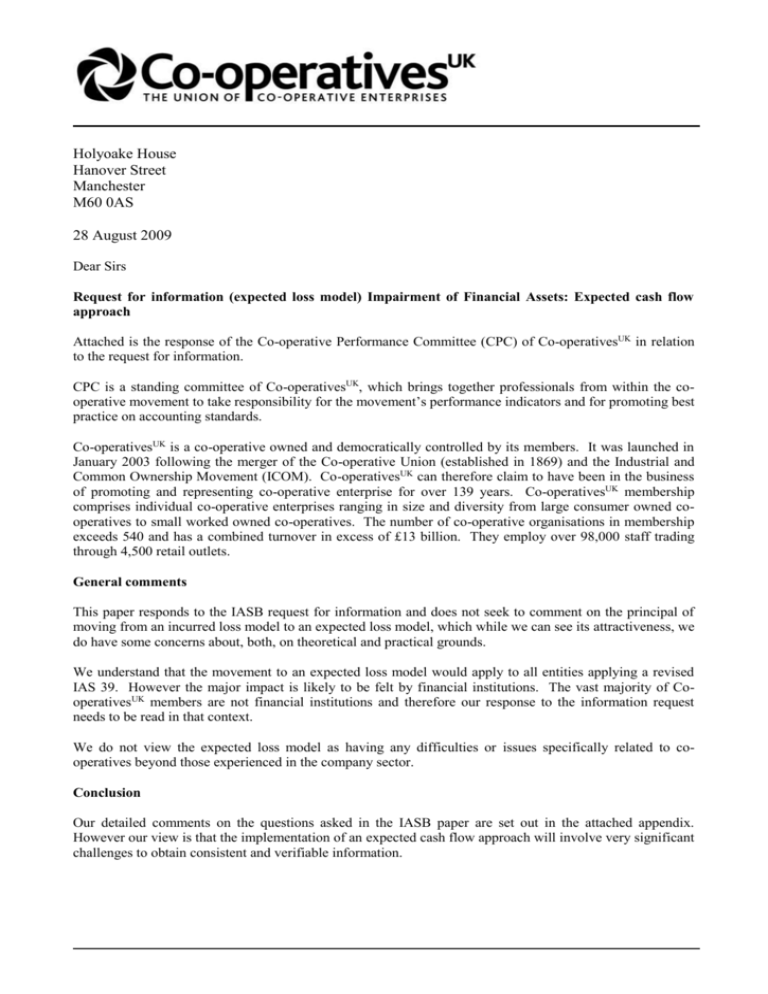
Holyoake House Hanover Street Manchester M60 0AS 28 August 2009 Dear Sirs Request for information (expected loss model) Impairment of Financial Assets: Expected cash flow approach Attached is the response of the Co-operative Performance Committee (CPC) of Co-operativesUK in relation to the request for information. CPC is a standing committee of Co-operativesUK, which brings together professionals from within the cooperative movement to take responsibility for the movement’s performance indicators and for promoting best practice on accounting standards. Co-operativesUK is a co-operative owned and democratically controlled by its members. It was launched in January 2003 following the merger of the Co-operative Union (established in 1869) and the Industrial and Common Ownership Movement (ICOM). Co-operativesUK can therefore claim to have been in the business of promoting and representing co-operative enterprise for over 139 years. Co-operativesUK membership comprises individual co-operative enterprises ranging in size and diversity from large consumer owned cooperatives to small worked owned co-operatives. The number of co-operative organisations in membership exceeds 540 and has a combined turnover in excess of £13 billion. They employ over 98,000 staff trading through 4,500 retail outlets. General comments This paper responds to the IASB request for information and does not seek to comment on the principal of moving from an incurred loss model to an expected loss model, which while we can see its attractiveness, we do have some concerns about, both, on theoretical and practical grounds. We understand that the movement to an expected loss model would apply to all entities applying a revised IAS 39. However the major impact is likely to be felt by financial institutions. The vast majority of CooperativesUK members are not financial institutions and therefore our response to the information request needs to be read in that context. We do not view the expected loss model as having any difficulties or issues specifically related to cooperatives beyond those experienced in the company sector. Conclusion Our detailed comments on the questions asked in the IASB paper are set out in the attached appendix. However our view is that the implementation of an expected cash flow approach will involve very significant challenges to obtain consistent and verifiable information. We accept however that there may be some advantages with the expected loss model and consider that the IASB should continue to investigate this approach. We believe that the IASB should continue to seek views on this issue and develop any proposals carefully to ensure that the benefits clearly outweigh the potentially significant costs to the preparers of financial information. Yours sincerely Phil Holmes FCCA Secretary – Co-operative Performance Committee Appendix Detailed response to the question set out in paragraph 11 of the IASB paper. Question 1 - Is the approach defined clearly? If not what additional guidance is needed and why? The overall approach is defined clearly with the main features of both approach well set out. However the request for information is necessarily set out at a high level, any resulting standard would need to have guidance dealing with the detail of the operational issues that result from this approach – see below. Question 2 - Is the approach operational (ie capable of being applied without undue cost)? Why or why not? If not how would you make it operational? We believe that this approach could lead to significant cost being incurred by entities. Costs arise from a number of issues: - collection of data While we would expect that initial inputs to any model would be historic data, such data might not be available easily from institutions existing systems, particularly if assets are managed on a portfolio basis and may now need to be assessed for loss on an individual basis, or vice versa. It would therefore be helpful for IASB to consider a hierarchy of data that might be used in these models and the likely sources of such data. Similarly expected loss models will need to have inputs about future economic conditions to adjust the historic data for future expectations. We believe that this could be complex and therefore costly due to: - complexity of model building - choice of data - verification of data against some objective criteria We believe that any standard must give guidance in these areas to make sure that calculations are being prepared on an appropriate and consistent basis. Guidance on data sources to minimise the use of unobservable inputs into models would be helpful. - movement in and out of portfolios There is, as the paper is necessarily at a high level, some uncertainty as to how this will work in practice and we suggest that the IASB should give some more guidance on this. However, depending on how this develops there could be a requirement for significant systems changes to cope with managing assets on an individual or portfolio basis and managing the interaction between the two. - effective interest rate calculation increases complexity The requirement to continuously re-evaluate the effective interest rate on variable interest rates when credit losses have to be factored in and will add significantly to complexity and cost. Our view is that the implementation of this approach will involve significant systems changes to a number of related information systems and will therefore involve both time and cost. Question 3 - What magnitude of costs would you incur to apply this approach, both for initial implementation and on an ongoing basis? What is the likely extent of systems and other potential changes that would be required to implement the approach as specified? If proposals are made, what is the required lead time to implement such an approach? Our members have not been able to give us a view on magnitude, other than it could be significant, particularly on implementation. As noted above we believe the systems changes could be substantial. However to some extent this is dependent on the detail relating to some of the issues identified above. If proposals are made in our view there needs to be a long transition period to allow organisations the necessary time to make the changes required. Question 4 - How would you apply the approach to variable rate instruments and why? See the appendix for a discussion of alternative ways in which an entity might apply the expected cash flow approach to variable rate instruments. In general we would support the Approach A as set out in the appendix. Question 5 - How would you apply the approach if a portfolio of financial assets was previously assessed for impairment on a collective basis and subsequently a loss is identified on specific assets within that portfolio? In particular, do you believe: (a) Changing from a collective to an individual assessment should be required? If so, why and how would you effect that change? (b) A collective approach should continue to be used for those assets (for which losses have been identified)? Why or why not? Our view is that the collective approach should continue to be used. The issue here, it seems to us is how to make appropriate provisions without double counting. For example, it could be argued that the calculation of an expected loss for a portfolio of assets already deals with the position where certain assets within that portfolio are impaired and if it was required to change to individual assessments for those assets this could result in double counting. Question 6 - What simplifications to the approach should be considered to address implementation issues? What issues would your suggested simplification address, and how would they be consistent with, or approximate to, the expected cash flow model as described? Given the fundamental nature of this change we can see no easy simplifications.
